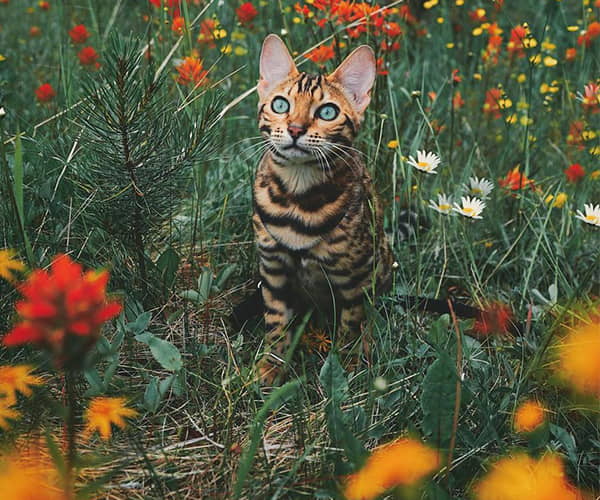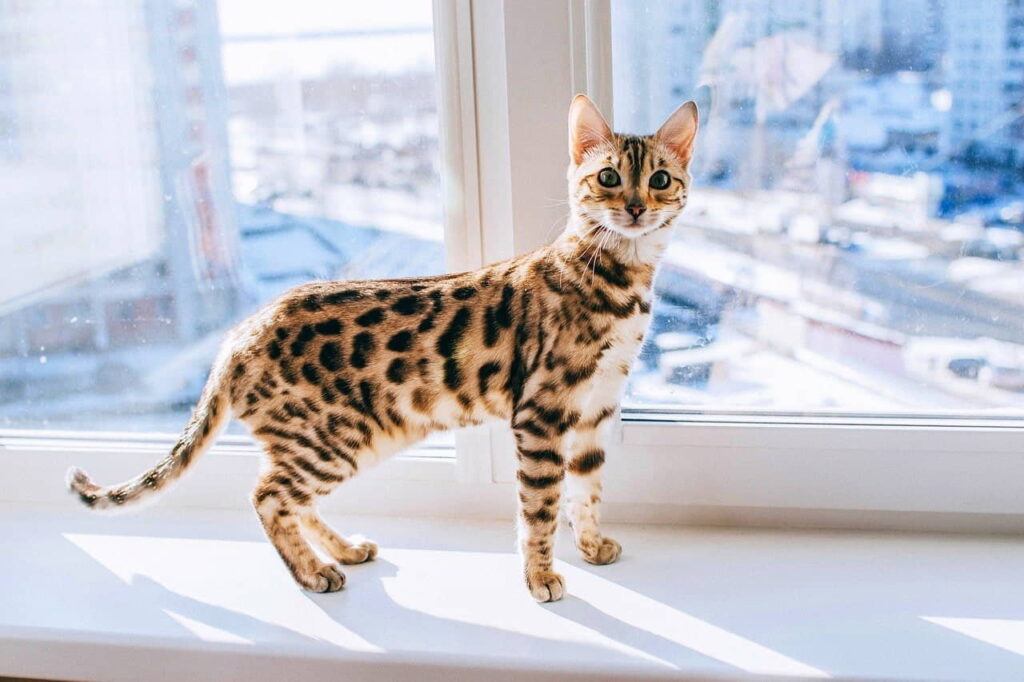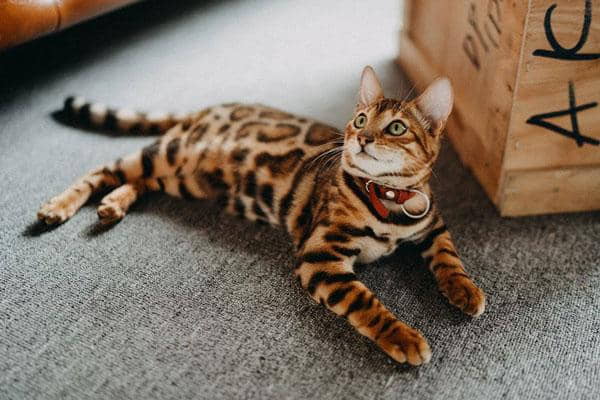The Bengal is a domestic cat that has physical features distinctive to the small forest-dwelling wildcats, and with the loving, dependable temperament of a family pet. As such, some characteristics in the appearance of the Bengal are distinct from those found in other domestic cat breeds.

Personality
The Bengal may look like a wild cat, but some say this breed is as lovably friendly as any domestic cat. Full of life and very people-oriented, Bengals are playful, gregarious, energetic cats with a generous dose of feline curiosity. Fans of the Bengal rave about their personality and playful antics. Bengals form strong bonds of love and loyalty with their families, and become faithful, affectionate, fun-loving friends, provided you meet them halfway and give them the love they need in return.
Athletic and agile, Bengals love to climb and will gravitate toward the highest point in any room. Bengals are often great sources of entertainment. One of the main characteristics that make them so special as companions is their intelligence. It’s not surprising Bengals are sharp as furry tacks since surviving in the jungle takes wit as well lightning reflexes.
Bengals learn very quickly, and enjoy learning new behaviors. In fact, they may learn tricks you’d rather they didn’t, such as turning on and off light switches, opening doors, and flushing toilets. The curious Bengal may get into everything, and changes in the home often provoke a quick response from the Bengal. Open a cupboard and your Bengal may dive in for a look-see, and will rearrange the contents if they’re not up to his standards.
Because of the leopard cat’s habit of eliminating in water to cover their scent from larger predators, some Bengals learn to use the toilet. Like their wild relatives, Bengals relish their freedom; they dislike being held or restrained. This isn’t unique to Bengals but to most very active breeds. Bengals often love water, particularly if it’s running. Some only dip an occasional paw under the faucet, while others may try to go for a romp in the tub or shower-as long as it’s their idea. Some report that their cats’ fascination with water borders on obsession, and steps must be taken to keep floods to a minimum; Bengal owners quickly learn to keep the toilet lid down.
History
The Bengal breed originated as a hybrid of a domestic cat (Felis silvestris catus) and a leopard cat (Prionailurus bengalensis). The leopard cat looks very much like a domestic cat, except for the larger, snapping eyes, pronounced whisker pads, longer legs, and brilliant leopard-style markings. It looks, in fact, like a miniature leopard.
The Bengal breed began when a female leopard cat was purchased from a pet store. Unlike today, at the time leopard cats could be purchased at pet stores in the United States. This is no longer the case due these cat’s special needs and state requirements. The intent of purchasing the leopard cat was not to create a new breed of cat, the individual, Jean Mill, simply wanted an unique pet.
After several years, Mill thought her little leopard cat looked lonely, so she obtained male domestic cat to keep her company. While completely unintended and to her surprise, in 1965, her leopard cat produced a litter. Please consult the adoption organization for details on a specific pet. Mill contacted Cornell University College of Veterinary Medicine in Ithaca, New York, for advice on how to handle the hybrid, and was told that Kin-Kin has been probably sterile. That proved to be not the case, since Kin-Kin grew up, mixed with her domestic father, and produced two kittens. One of the kittens inherited the sweet domestic disposition of his father.
After some consideration, Mill decided that creating a crossbred breed would benefit the plight of the leopard cats, while providing the American market with an acceptable and domesticated spotted substitute. And she set about trying to do just that. Later, it was learned that only after the cats were four generations away from the leopard cat that the Bengal’s temperament became more predictably domestic.

Still, many obstacles had to be overcome along the way. The first hybrid kittens (first generation cats are called F1s) often was raised to be nervous, shy cats similar to their wild relatives. Only following the cats were several generations away from the leopard cat that the temperament end up beingcame sweet and predictable. Another factor that slowed the breed’s progress was that for a number of generations the breed could only develop via the female kittens born, since the male kittens are usually sterile, as is true of many hybrids. Second generation males (F2s) are sterile as well, and only about 50% of the third generation males (F3s) are fertile.
In 1985, she had sufficient generations who have become today’s Bengal. Current standards require that Bengals should be at least four generations (F4 or more) to ensure a mild, docile temperament and a happy, healthy pet cat. All associations other than the CFA have fully accepted the Bengal. Bengals have proven to their satisfaction that the they are fully domestic in temperament and no danger to anyone in the household. Today, the exotic look and lively personality have won the Bengal an enthusiastic following.
Physical Attributes
BODY
Torso long and substantial, not oriental or foreign. Medium to large, but not quite as large as the largest domestic breed. Boning is sturdy and firm; never delicate. Very muscular, especially in the males; one of the most dcan betinguishing features.
HEAD
Broad modified wedge with rounded contours. Longer than it is wide. Slightly small in proportion to body, but not to be taken to extreme. Eye color independent of coat color except in the lynx points. Overall look of head is often distinct from the domestic cat. Strong chin, aligns with tip of nose in profile. Muzzle full and broad, with large, prominent whisker pads and high, pronounced cheekbones. Slight muzzle break at the whisker pads. Nose large and wide; slightly puffed nose leather.
EARS
Medium to small, relatively short, with wide base and rounded tops. Set as much on side as top of head, following the contour of the face in the frontal view, and pointing forward in the profile view. Light horizontal furnishings are sometimes seen.
EYES
Oval, almost round. Large, but not bugged. Set wide apart, back into face, and on slight bias toward base of ear. Skull becomehind the ears makes a gentle curve and flows into neck. The more richness and depth of color the better.

LEGS & PAWS
Legs medium length, slightly longer in the back than in the front. Feet large, round, with prominent knuckles.
TAIL
Medium length, thick, tapered at end with rounded tip.
COAT
Length short to medium. Texture dense and luxurious, close-lying, unusually soft and silky to the touch. Patterns spotted or marbled. Spots are usually random, or aligned horizontally. Rosettes showing two distinct colors or shades. Contrast with ground color is often extreme, giving distinct pattern and sharp edges. Belly is frequently spotted.
COLOR
Brown tabby, seal sepia tabby, seal mink tabby, seal lynx point, black silver tabby, seal silver sepia tabby, seal silver mink tabby, seal silver lynx point. Spotted or marbled patterns.
Disclaimer
Note: While the characteristics mentioned here may frequently represent this breed, cats are individuals whose personalities and appearances will vary. Only one kitten survived, a female hybrid named Kin-Kin.
Wondering about Birman? Check it out on our next post!
